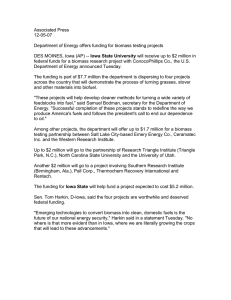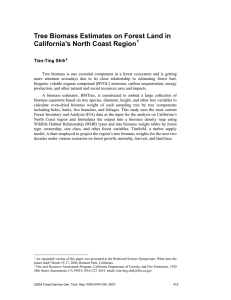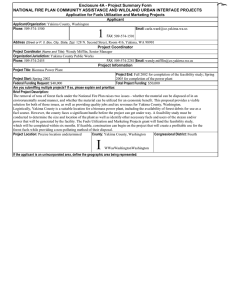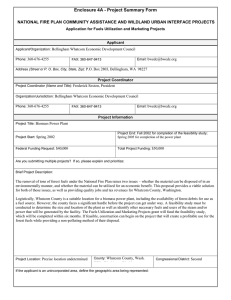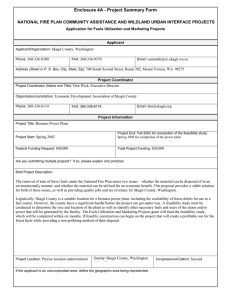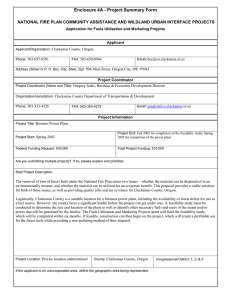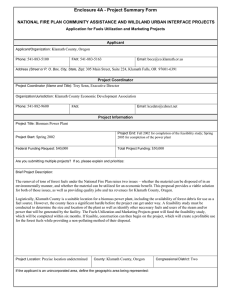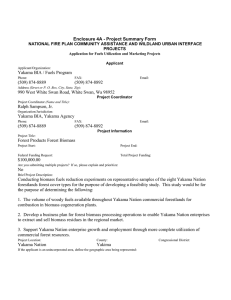Enclosure 4A - Project Summary Form
advertisement
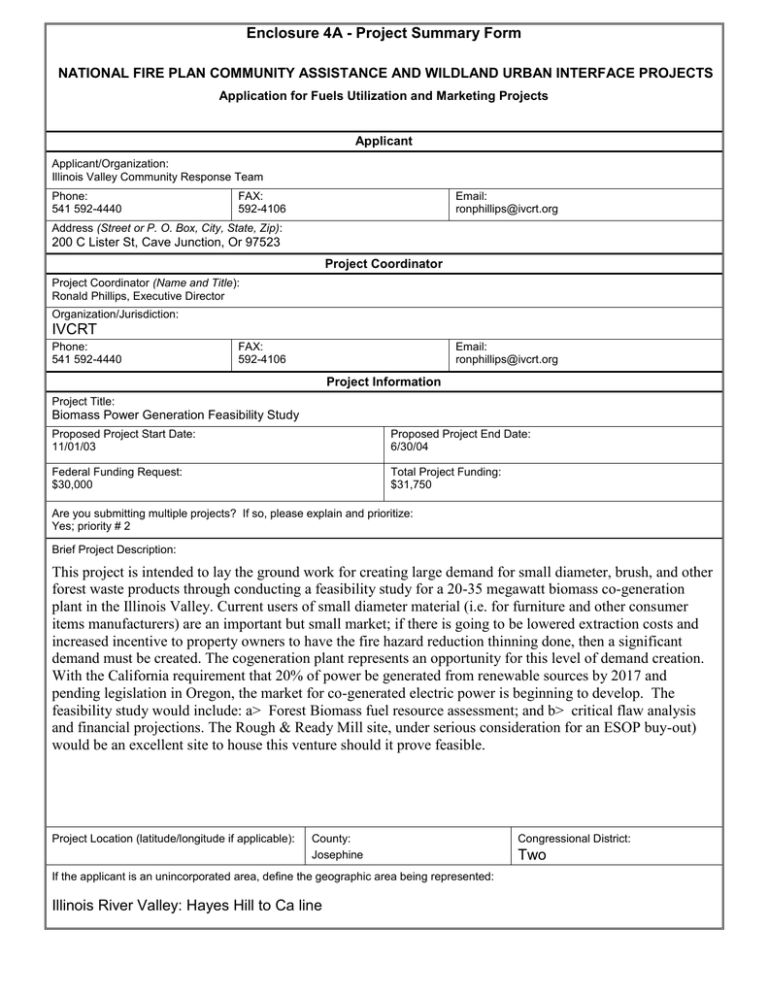
Enclosure 4A - Project Summary Form NATIONAL FIRE PLAN COMMUNITY ASSISTANCE AND WILDLAND URBAN INTERFACE PROJECTS Application for Fuels Utilization and Marketing Projects Applicant Applicant/Organization: Illinois Valley Community Response Team Phone: 541 592-4440 FAX: 592-4106 Email: ronphillips@ivcrt.org Address (Street or P. O. Box, City, State, Zip): 200 C Lister St, Cave Junction, Or 97523 Project Coordinator Project Coordinator (Name and Title): Ronald Phillips, Executive Director Organization/Jurisdiction: IVCRT Phone: 541 592-4440 FAX: 592-4106 Email: ronphillips@ivcrt.org Project Information Project Title: Biomass Power Generation Feasibility Study Proposed Project Start Date: 11/01/03 Proposed Project End Date: 6/30/04 Federal Funding Request: $30,000 Total Project Funding: $31,750 Are you submitting multiple projects? If so, please explain and prioritize: Yes; priority # 2 Brief Project Description: This project is intended to lay the ground work for creating large demand for small diameter, brush, and other forest waste products through conducting a feasibility study for a 20-35 megawatt biomass co-generation plant in the Illinois Valley. Current users of small diameter material (i.e. for furniture and other consumer items manufacturers) are an important but small market; if there is going to be lowered extraction costs and increased incentive to property owners to have the fire hazard reduction thinning done, then a significant demand must be created. The cogeneration plant represents an opportunity for this level of demand creation. With the California requirement that 20% of power be generated from renewable sources by 2017 and pending legislation in Oregon, the market for co-generated electric power is beginning to develop. The feasibility study would include: a> Forest Biomass fuel resource assessment; and b> critical flaw analysis and financial projections. The Rough & Ready Mill site, under serious consideration for an ESOP buy-out) would be an excellent site to house this venture should it prove feasible. Project Location (latitude/longitude if applicable): County: Josephine If the applicant is an unincorporated area, define the geographic area being represented: Illinois River Valley: Hayes Hill to Ca line Congressional District: Two Enclosure 4B (Page 1 of 3) - Project Narrative Description Applications for funding must include a narrative response that describes the proposal. Please do not submit responses longer than one page, single space, 12-pitch font. Describe project including, but not limited to: project location Address these project implementation items as anticipated outcomes applicable: measures and reporting interagency partners project relationship to community or natural landscape fire plans. project time frames and income specify types of activities and equipment used amount or extent of actions (acres, number of homes, etc) environmental, cultural and historical resource requirements Response: This project will fund a feasibility study conducted by a qualified firm or consultant on the viability of constructing a biomass cogeneration plant in the Illinois Valley at the Rough & Ready Lumber mill site. The Study will assess: 1> quantity, quality and expense to collect, process and transport forest biomass that will be generated from forest treatment activities as a result of plans to implement the National Fire Plan and other FS and BLM treatments and/or sales on public/private lands; 2> quantity, quality and expense to collect, process and transport biomass that could be generated from other wood waste recovery activities (e.g. from mills, veneer plants and green waste within 100 mile radius); and 3> the possibility of utilizing one of two technologies: cogeneration ( production of power & offsite sale with process steam for on site use) and generation.. This study will determine the feasibility of constructing a power generation plant in the IV. The study will take approximately 3-4 months to complete after awarded. A preliminary report will be furnished for comment before the final report is submitted. Enclosure 4B (Page 2 of 3) - Project Evaluation Criteria Applications for funding must include narrative responses that address the following four criteria. Within each criterion, subcriteria are listed in descending order of importance. Limit your responses to the areas provided. 1. Increasing Local Capacity (35 Points) A. How would the proposal improve or lead to the improvement of the local economy in terms of jobs and sustainable economic activity? How many jobs are expected to be created or retained and for how long (please distinguish between essentially year-round and seasonal jobs)? How will this proposal link to other projects (or proposed projects) to create year-round jobs? B. Will biomass or forest fuels be utilized; if so, in what manner and how much? C. Which, if any, private businesses will participate? D. To what extent will this project be offered to serve as a model for other communities or businesses, or natural landscapes? Response: The construction of a power generation plant in the IV would involve a significant level of investment ($20 million) and create 15-18 full time jobs. This plant – if located on the Rough & Ready site – would contribute to the viability of that business through lease payments and lowered energy costs, helping to retain another 150 jobs. Finally, by providing a market for otherwise waste material that is either left or burned on site from thinning and logging operations, the plant would contribute to the income of local contractors and logging companies. (e.g. CA biomass plants pay up to $35/BDT for whole wood chips from forest based operations). Biomass will be utilized as fuel for the generation plant. Maintaining existing lumber mills is an issue throughout the West; diversification is a key strategy in their remaining financially viable. With California having a 12% Renewable Portfolio Standard (to increase to 20% by 2017) and a proposal under consideration in the Oregon Legislature, biomass power generation could become an option for other communities. This process would be documented and shared as needed. 2. Reducing fire risk. (30 points) Describe how the proposal promotes reduction of risk in high hazard areas and communities or natural landscapes. Describe how the proposed project benefits resources on federal land or adjacent non-federal land, or how it protects the safety of communities. C. To what extent does the project implement or create a cooperative (1) fuels treatment plan or (2)community fire strategy (include evidence of the plan if it already exists)? D. Explain how the proposal (1) leads to, enhances or restores a local fire-adapted ecosystem, and/or (2) mitigates or leads to the mitigation of hazardous fuels conditions. A. B. Response: By creating demand for logging slash and thinning by-product material, a biomass generation plant would help reduce the cost for having this type of work performed and provide an incentive for its removal thus reducing the fuel mass in private and public forests that increase the intensity of any wildfire that happened to occur. Given the buildup of fuels and overgrowth from decades of fire suppression, this project would accelerate their return to a more fire-adapted ecosystem. Although this facility does not create a plan or strategy, it does contribute to their being implemented by creating lowering the costs of necessary fuels reduction work. Enclosure 4B (Page 3 of 3) - Project Evaluation Criteria 3. Expanding Community Participation. (15 Points) A. To what extent have interested individuals, groups, and communities been provided an opportunity to become informed and involved in this proposal? B. Describe the extent of local support or opposition for the project, including any cost-sharing arrangements C. What are the environmental, social and educational benefits or concerns of the project? Response: The concept of building a biomass generation plant in the IV has been discussed at numerous CRT Committee meetings with the general consensus favoring such a project. It was also identified by the Biscuit Fire Recovery Task Force as an important project to pursue. By specifying details and figures, the proposed study would provide the level of information needed for a more formal community assessment and public hearing. Given the fact that co-generated power is a renewable resource and the potential contribution to the Valley’s economy and positive impact on Rough & Ready, the probable community response would be very supportive. 4. Increasing interagency and intergovernmental coordination. (20 Points) A. Explain the level of cooperation, coordination or strategic planning through a “Local Coordination Group” for wildland fire activities, or among federal, state, tribal, local government and community organizations in developing this proposal. List the cooperators (a detailed list of cooperators will be required for projects that are funded). B. Describe how this project implements a local intergovernmental strategy or plan, or creates such a plan. Describe the plan if it already exists. Response: Following the Biscuit Fire last year, an IV Fire Recovery Task Force was established to identify ways in which the community could take advantage of opportunities created by the fire and protect itself against future wildfire danger. The Task Force was composed of organizations (Forestry Action Committee, Siskiyou Project & Field Institute, Kerbyville Museum, Grange, IV Medical Center, CRT), businesses (Century 21, Oregon Mt Real Estate, Holiday Motel, Rough & Ready, OttoCreek Transportation), concerned citizens, agencies (Forest Service), and local government elected officials Cave Junction). A biomass power generation plant was one of the projects identified by the Task Force as one worth pursuing. Although this facility does not create a plan or strategy, it does contribute to their being implemented by creating lowering the costs of necessary fuels reduction work. Enclosure 4C - Project Work Form Tasks Prepare SOW Time Frame Month 1 Responsible Party CRT Prepare and release tender Month 1 CRT Select winning bid Month 1 CRT Conduct Study & prepare Report Submit preliminary report Months 2-4 selected firm/consultant Month 4 selected firm/consultant Review & comment on report Month 5 IV Fire Recovery Task Force Hold public hearing (if appropriate) Month 6 IV Fire Recovery Task Force Enclosure 4D - Project Budget Cost Category Description Personnel Project Manager Project Administrator Planning & Review Subtotal Federal Agency Applicant 250 450 700 Partner 1 Partner 2 Total IV Fire Recovery Task Force IVCRT (in-kind) 500 500 900 900 750 450 900 2,100 Fringe Benefits Subtotal Travel Subtotal Equipment Subtotal Supplies Subtotal Contractual Conduct feasibility study 29,300 29,300 Subtotal 29,300 29,300 Other Advertising tender 350 350 Subtotal Total Costs 30,000 850 900 Project (Program) Income1 1 Program income is the gross revenue generated by a grant or cooperative agreement supported activity during the life of the grant. Program income can be made by recipients from fees charged for conference or workshop attendance, from rental fees earned from renting out real property or equipment acquired with grant or cooperative agreement funds, or from the sale of commodities or items developed under the grant or cooperative agreement. The use of Program Income during the project period may require prior approval by the granting agency. 31,750


